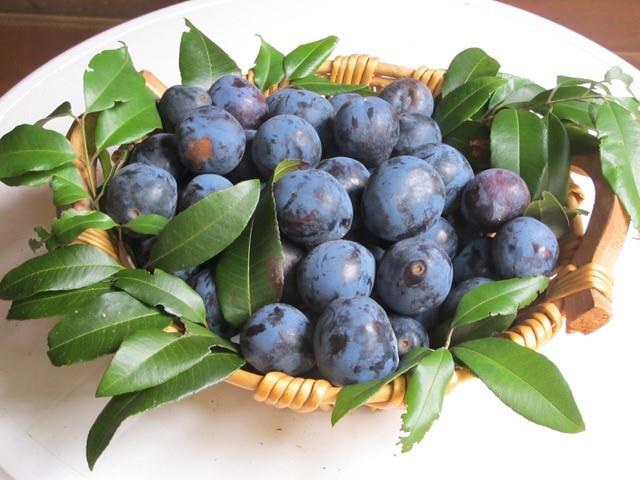Bush Foods – An Aussie Culinary Experience

Author: Lawrie Smith AM
Published: Online Only March 2023
Image above: Tantalising and luscious ‘Plums’ with a ‘frosty’ texture, from the Australian rainforest understory.
When you enjoy a slice of Pizza you immediately think of Italy; when you enjoy Sushi your taste buds fly to Japan; a serving of Crème Brulee transports you to the Champs Elysée in Paris; and a hot dog with ketchup can only be the United States; every nation has its own special memorable culinary experience.
Our ever-expanding multicultural Australian population has been living in this great south land for just over 200 years, and with us we brought our familiar cuisines from around the world. Until comparatively recently, despite this diversity of tastes, no renowned uniquely Australian foods have emerged. We are slowly learning from our first nations people how they lived comfortably for 60, 000 years on this the worlds driest continent. They have always been sustained by a wealth of wildlife and the native plants diversity, all offering a range of rich and healthy natural foods, while others contain beneficial medicinal properties.

You don’t have to be a chef! This is so easy to do and relaxing too!!
Native food plants discovered
It is great to see that now Australians are beginning to learn that across the country, throughout our varied natural environments, we have access to a considerable and unique resource of native plants that have the potential to make a major contribution to our lifestyle, culture and most importantly to our national cuisine. The first settlers in 1788 at Port Jackson (Sydney Harbour) learned very quickly about this available natural bounty, which they used to augment the meagre British foods they brought with them, that were struggling in the inhospitable soils.
Macadamia Nut – Macadamia integrifolia
Moving forward two centuries, perhaps the most well-known edible native plant fruit is the Queensland Nut or Macadamia, found growing naturally in random locations from Northern NSW to Central coastal Queensland. Recognised as one of the worlds most useful and delicious nuts, ‘our Queensland Nut’ is now cultivated in extensive orchards for local consumption and for export internationally. It makes a major contribution to our more specialised dishes at top restaurants, or simply as a delicious snack with a drink or two. Also suited as a welcome productive and attractive specimen tree for the home garden.
Davidson Plum – Davidsonia pruriens
Another lesser known Aussie food is the Davidson Plum, with a delectable fruit similar to the well-known exotic plum. The fruits follow attractive sprays of pink flowers, emerging all along the trunk and branches; these develop into clusters of egg size dark purple skinned ‘plums’ lightly frosted in grey. The flesh is a delightful ruby red colour, very juicy with a pleasing but tart taste. There are two small flat seeds inside, so apart from these the whole fruit skin and all, is edible but best used for jams, jellies and sauces.
The flavour is delectable and intense, with a very similar taste to exotic Rosella Jam – absolutely wonderful on scones and cream, great for breakfast on multigrain toast and unforgettable as a sauce on a bowl of ice cream. Only recently processed products of this amazing fruit have become more readily available in supermarkets and specialty markets. Not only that but Davidson Plum makes an attractive small upright productive feature tree for residential gardens.

Decorative sprays of tiny pink flowers give promise of a bumper crop of ‘Plums’.

Clusters of egg size ‘plums’ hang down and drop as they ripen.

Juicy ‘Plums’ have a pleasing tart flavour, ideal for jams and sauces; first remove the two flat seeds and then plant them!

Nothing betters ‘Davidson Plum Jam’ on a hot scone, with fresh whipped cream and a good Aussie ‘cuppa’ of Lemon Myrtle tea.
Make Your Own Davidson Plum Jam
- Collect the fruit and remove the seeds (two per fruit). Cut around the ‘equator’ of the fruit, then split apart and remove the two flat seeds. No need to cut the fruits into smaller pieces.
- Put the fruit into a saucepan and add just enough water as to be barely visible under the fruit pieces. Davidson Plums are juicy and do not need as much added water.
- Boil lightly for about 15 to 20 minutes until soft. Then using a blender or whisk reduce the fruit to a coarse pulp.
- Using a cup, measure how much boiled fruit there is, and then put it back into the saucepan together with an equal volume of raw sugar. (I prefer to add only two thirds the volume in sugar so the jam is sweet/tart.) Stir and add in the juice of one lemon (optional).
- Boil lightly for 20 to 25 minutes, test on a cold plate to see if it jells.
- When done, bottle and put on the lids while the mixture is still hot.
Observing Bush Foods
It is not easy to find edible native plants in forests, parks and gardens, and to be sure that you know its correct identification. Know that some plants have chemical properties that could be poisonous or cause unwanted health impacts. Therefore, a fundamental rule is “never eat any part of a plant if you are unsure of the species identification and/or its health properties”.
One excellent way to be introduced to a wide range of native plants which are well known as bush foods, is to visit Roma Street Parkland and take a ‘Bush Tucker and Rainforest’ guided walk where you will be introduced to an impressive collection.
To book a free guided tour, check the website www.romastreetparkland.com complete the booking form and email it to rsp@cityparklands.com.au at least two weeks prior to your proposed visit.
